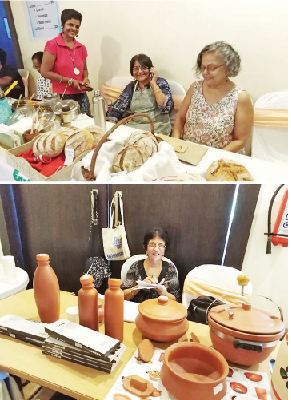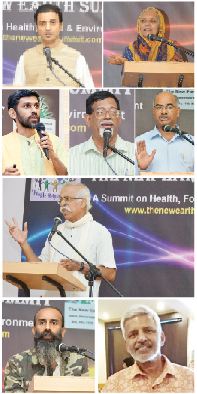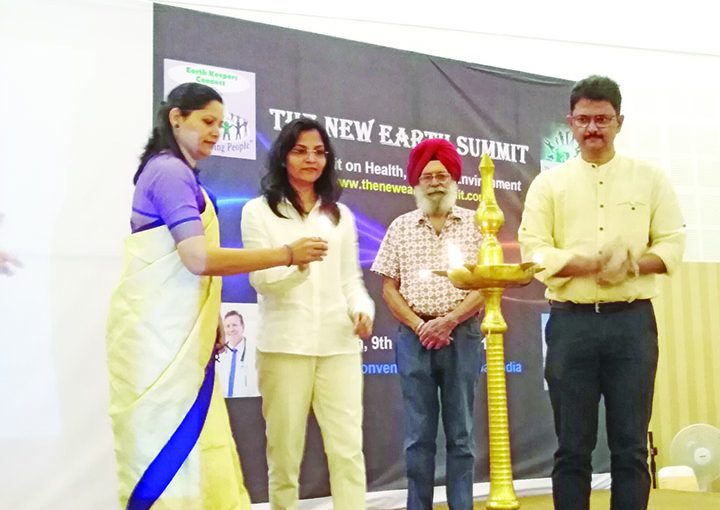At Goa’s first ever New Earth Summit: All for a healthier Goa are (l to r) Vandana S Naik, Dr Shikha Aggarwal, Peter Singh, AAP’s Elvis Gomes who was inaugural chief guest
Tara Narayan spent some time at the New Earth Summit and came away with lots of food for thought….
WHO isn’t seeking a makeover for a better today? Who is not in search of an eco-friendly lifestyle to sow and reap a harvest of wealth, health, happiness — in any order of priority you wish and are willing to work for! There was lots of food for thought and amusement at The New Earth Summit (where various speakers focused on health, food and environment issues) over the three-day weekend of November 8, 9 and 10, 2019. What organiser Darryl D’Souza, the creator of Earth Keepers’ Market and convenor-organiser-moving spirit behind the summit seeks in the long run is a people to people interaction for a healthier Mother Earth in Goa and elsewhere, the country over, globally — begin at your own home first.
The New Earth movement as one may call it is to create a mass awareness about the root causes of our chronic health problems today. They are courtesy a much degenerated, contaminated, toxic Mother Earth (which yes, our human civilization is responsible and accountable for)…how we live is very definitely a reflection of how we are dying prematurely be it from long-term suffering from high blood pressure (or low blood pressure) or heart disease or cancer and everything else which comes in between (be it old age handicapped by increasing deafness, blindness, immobility). A younger generation is aware of what a sorry mess our civilization is in and wants to do something to create a more sustainable model of lifestyles for human beings.
More than anything it is about making connections and that’s actually what various speakers at the summit did in their respective talks to do with chronic health, the food we eat, the earth beneath our feet, the kind of homes we live in (not healthy at all for our needs, say Hyacinth Pinto and Tallulah D’Silva), the decentralized medicine system of the future, organic farm food and natural farming systems, the need for fresh, organic, local food… sustainable livelihoods, forest nurseries and restoring mangroves to save coastal economies, Goa as a tourism wellbeing destination, and much more.

Alas, barely 100 to 250 people turned up for a day or for all three days of the summit. Darryl D’Souza is the first to confess his expectations were higher but if one goes by numbers turnout on the surface of it, it does mean that few of us make the connections between healthcare, food supply, living spaces and our environment and the Earth Keepers Connect of “People Helping People” still has to gather momentum as a mass movement even in its home state!
This is to say that those who did register from in and out of Goa are committed to the cause and happy and grateful for the sessions of enlightenment about how we can individually and collectively, if we have a mind to — help create that near ideal life and world of an eco-friendly, self-sustaining and diverse local economy offering achhe din for all in Goa. Goa can set an example for the world like Sikkim or Bhutan are doing with their exemplary governance and picture of happy, contented people by and large.
The summit was to focus on alternate ways of healing from the chronic illnesses of time in which mind, body and spirit have a bearing on one another. Dr Shikha Agarwal of the Healthy Healing Centre in Sangolda spoke about “Healing Your Digestive System” and offered insight into digestive and gastro-intestinal problems, chronic fatigue and brain fog, heavy metal toxicity-related problems, allergies and asthma, candidiases and other infections, cardiovascular and peripheral vascular diseases, metabolic syndrome and how manage chronic pain. The articulate Varsha S Naik, research scholar in nutrition and associated issues par excellence offered exhaustive insight into “Reversing Chronic Illnesses with Diet & Lifestyle Changes.” She spoke of various ways in which we may improve our nutritional inputs in our daily diet for diet plays a vital role in staying fit and fine. The key words are “We all need behaviour modification!”
There was quite a bit of focus on farming your own organic food for better nutrition values and health and successful small scale farmer in Goa, namely Karan Manral who pertinently noted that fresh food is a necessity in India and we are lucky that we may still see it around us. We must consume fresh food if we want to be healthy and fit for life. He presented a model of how to set up a natural farming system at home, or balcony, or a bit of ground — he himself started out being an organic farmer with only two pots but over five years has “made inches of progress!”
Meaning farming is uphill task but worth it once the rewards roll in, “it is a consumption choice and a systems choice we have to make. Start which what I can do, what I can control…” You can at least control what you put in your mouth if you grow your own food and that’s a big achievement. From a kitchen garden you can graduate to balcony, terrace, garden, homestead farming…the best way to farm is to mimic nature, “save your own seeds and use them again and again.” Nutrition lies in the quality of your soil and seeds.

Also on the subject of organic farmers were stalwarts of the botanical and organic farming movement Miguel Braganza (who testifies to how perceptions about farming are changing and how fashionable it has become to do a bit of organic farming in Goa today), Clea Chandmal, Neville Alphonso. In a most interesting presentation Deputy Director, Goa Department of Agriculture, Neville Alphonso, traced the sins of the green revolution. But now the Goa government is promoting organic farming with subsidy schemes like the one for organic “cluster” farming, meaning everything is readymade more or less — minimum requirement is 20 hectares and 20 farmers coming together, they can avail of a subsidy of 50,000 over three years, and much else. The idea is to help organic farmers be their own entrepreneurs and businessmen, “no third person making money here”). The scheme is eco-friendly, invests in low cost technology, empowers farmers. What more can today’s disheartened and suicidal farmers ask for? The truth unfolding before our eyes is that organic farming is actually more rewarding in a myriad ways than being an engineer or an IT professional these days! Educated, white-collared professionals who once looked down on muddy earth are now not only changing their mind and bringing their ancestral pieces of land back to life, growing organic vegetables, fruit and herbs, but also rejoicing in whatever they put in their mouth because it comes from their farm…this is real life-giving food they can trust! A far cry from the plethora of foods we eat day in day out from packets, cans and the marketplace which offer ill-health courtesy the sordid nitty gritty story of conventional farming dependent on chemical fertilizers and pesticides, as also the food industry which works along promoting shelf life for a mind-blowing range of industrially processed foods. Others who contributed to the seminal talks were Anny Kohli and Jay Sutaria, who’re promoting heirloom super foods sun cured spirulina and hemp seeds, hemp seed oil, hemp hearts, hemp protein powder, hemp and khapli flour, Kumudi gond, Himalayan herbs and flower teas, etc, as also providing farmers with an agenda and help for growth and livelihood by helping them in farming, organizing and marketing courtesy an online site. Interestingly, hemp oil is one of the super foods which is being much talked about these days as the treatment for cancer. But there is some kind of a controversy about what is hemp and what is marijuana, and which parts of the two plants are psychoactive — from the sound of it both are cousin plants, with hemp being a strain of the Cannabis sativa plant and now grown specifically for industrial uses which includes the making of hemp fibre (even hemp biodegradable plastics). Cannabis sativa is generally interpreted as marijuana or our homegrown “bhang” mixed into the much relished energy milk drink called “thandai” during Holi celebrations in India. Marijuana extracted from plant and leaves is said to be psychoactive or intoxicating and an effective painkiller. The controversy sharpened after President Trump last year signed a farm bill containing a provision legalising hemp, a species of cannabis that CBD can be extracted from which isn’t so psychoactive (historically, hemp was illegal to sell or grow in the US but legal tender now from all accounts). It seems what you derive from the plants’ flowers, leaves and stems is psychoactive, while derivatives from hemp seeds like oil, hearts, flour, etc, are cannabinoid-free, meaning not psychoactive. There’s a lot more to this than meets the eye and I wonder if it’s a deliberate controversy for pharmaceutical reasons to fudge reasons legal and illegal. But I liked the heavy pungent taste of hemp oil, lighter taste of the hemp hearts and crackers, which were on offer for tasting with the formidable Anny Kohli adding a pinch or two of rock and black salt (“slow iron-roasted”) into a “chaat” on offer at her stall — a chaat of fresh moong sprouts tossed in hemp crackers, tamarind sauce, a sprinkling of mineral salt…delicious and agreeable (even if priced at100 per pudi). There were several other alternative lifestyle stalls at the venue of the summit, all meriting attention all on their own. Someone was retailing much in demand premium coffee featuring non-dairy milk like almond or soybean milk and do you know there is a turmeric tea now being marketed by Organic India?
There was lots more to learn, understand and appreciate at the New Earth Summit and one cannot but wish for more of them in Goa in the near future. May all movements for a greener, healthier, happier Goa grow from strength to strength and may Chief Minister Pramod Sawant’s government take stock of the people’s will to put livelihood and environment first on their list of priorities in this respect. Goans have been repeatedly saying in recent times not to push the small, environmentally vulnerable state of Goa, into the mouth of more and more industrial progress and development at the expense of air, earth and water — all indication of a paradise which has been negatively affected for want of governmental prudence, insight and wisdom! If one may say so.
